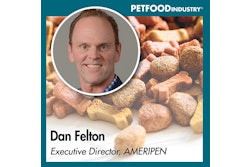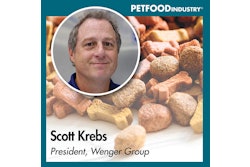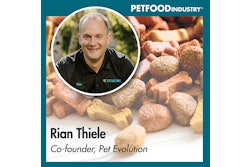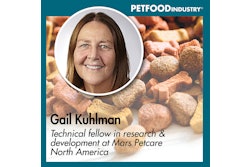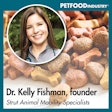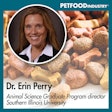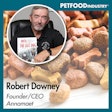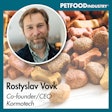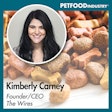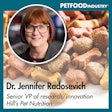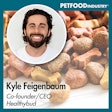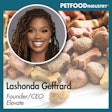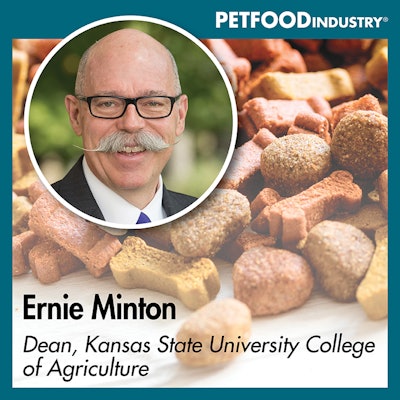
I spoke with Ernie Minton, dean of Kansas State University's College of Agriculture and director of K-State Research and Extension, about all things academia and pet food: What's needed to get students interested in pet food, where agriculture fits in and what K-State is currently doing to expand research opportunities and build career bridges.
The below transcript is from Episode 42 of the Trending: Pet Food podcast, where I spoke with Dean of Kansas State University's College of Agriculture and Director of K-State Research and Extension, Ernie Minton, about a new research facility as well as the future of agriculture, pet food and academia. You can find the episode at www.PetfoodIndustry.com/trending-pet-food-podcast, on SoundCloud or on your favorite podcast platform. This episode originally aired on August 23, 2023.
A SPECIAL NOTE FROM THE HOST
Hello, podcast listeners! This is your host, Lindsay Beaton, and I'm jumping in to ask a quick favor. I've launched an audience survey for Trending: Pet Food, and I would absolutely love to hear your thoughts on the podcast now that we're nearly 50 episodes in. You can find the survey at www.PetfoodIndustry.com/podcast-survey, And there's also a QR code floating around on the podcast Instagram @trendingpetfoodpodcast, as well as on LinkedIn. The survey will be active through the end of August, and if you could take just five minutes or so — I promise; I took the survey myself to make sure! — to provide your insights it would mean a lot for the future of the show. Thanks so much, and enjoy the episode!
(We want to thank AFB International for sponsoring this podcast. AFB is the premier supplier of palatants to pet food companies worldwide, offering off-the-shelf and custom solutions that make pet food, treats and supplements taste great.)
Lindsay Beaton – Editor, Petfood Industry magazine and Host, Trending: Pet Food podcast
Hello, and welcome to Trending: Pet Food, the industry podcast where we cover all the latest hot topics and trends in pet food. I’m your host and editor of Petfood Industry magazine Lindsay Beaton, and I’m here today with Ernie Minton, dean of Kansas State University's College of Agriculture and director of K-State Research and Extension. Hello, Dean Minton, and welcome!
Ernie Minton – Dean, Kansas State University College of Agriculture
Lindsay, it's good to be here and I'm happy to share with you about our interests and pet food here at Kansas State University's College of Agriculture.
Beaton: In his current role, the Dean is focused on advancing the college’s agriculture legacy as one of the nation’s top academic programs, and K-State’s Research and Extension’s mission through research, outreach, engagement and economic development.
Prior to being named Dean in 2019, he spent 25 years as a faculty member for the Department of Animal Sciences and Industry at K-State and was recognized as one of the world’s top 2% of scientists within his field, according to a 2020 Stanford University study. Starting in 2008, Dean Minton began serving in administrative roles, including as associate dean for research and graduate programs and associate director for the Kansas Agricultural Experiment Station.
During his tenure as Dean, the College of Agriculture has been ranked in the top 10 nationally by two different independent assessments.
Dean Minton is actively involved in the Association of Public and Land-grant Universities, which is a reflection of his deep personal belief in the mission of the land-grant university system and the opportunity it offers for advancing the public good. He serves as chair elect for APLU’s Board on Agricultural Assembly Policy Board of Directors.
The mission of the Department of Grain Science and Industry at K-State is to advance the global grain and plant-based food, animal food, and bioproduct industries through scholarship, research and outreach.
The department is proud to be the primary training ground for technology specialists, scientists and managers who lead businesses and organizations in working to preserve harvest, process grains into products and nourish a hungry world. As one of the very few places in the world to offer bachelor's degrees in the areas of bakery science, milling science, and feed science and management, the university’s students benefit from exceptional faculty, resources and job opportunities.
K-State’s well-established role in the pet food industry, as well as plans for a new global research center, is why I’ve brought the Dean on to answer today’s question: What role will academia play in the future of the pet food industry?
We are going to get into all of that, but first, I like to hear people's origin stories. So, I would love to hear about how you ended up in your current position and what your connections are to agriculture that led you in this direction.
Minton: I'm happy to share that I'm a native of Kentucky; specifically, I grew up in Bowling Green, Kentucky. And actually, both of my parents were from small family farms in Kentucky. They were both born in the 1920s; they're deceased now. And so they were Depression-era children and going to university, going to college was not something that was common, you know, at that time, necessarily, but my father did. And when he did, the advice was, at that time, because things were so tough: Get an education, leave agriculture and don't look back. And so he became a university professor, and later a university administrator, so maybe I come by that legitimately. But my grandfather and grandmother still owned a farm and it was, I mean, looking back, frankly a subsistence farming situation. He was a tobacco farmer. This was Kentucky at the time, [and] it still is an important cash crop there. But nonetheless he had livestock too, particularly beef cattle, and I just couldn't get enough of interacting with them, and I made the decision that I somehow wanted to be involved.
But because we didn't, as a family, own farm land, I began to think as I got into college, “How am I going to make this connection?” And I majored in agriculture with an emphasis on animal science, and became intrigued with the science end of things. And so I discovered that at land grant universities, you can combine that love of science with a love for agriculture. And so I became an agriculture scientist. And then as I came to K-State, of course. I taught for 25 years in the Department of Animal Sciences and Industry, but also had a research career as well. But anyway, that's my story. I went through graduate school after graduating from Western Kentucky University; this would be a non-land grant College of Agriculture there with a four-year agriculture degree. I went to OSU from 1977 to 1983, and in 1983, I came to K-State.
So actually, this year, I'll have been at K-State 40 years. In fact, this month yet will be 40th anniversary here at K-State. So I've spent my entire career here at K-State, a product of the land grant system out of Oklahoma State University, and really began to understand, appreciate and try to promote the importance of land grant universities, and specifically colleges of agriculture, in contributing to feeding the world.
Beaton: Okay, congratulations on 40 years. That's quite the accomplishment, I think.
Minton: Thank you very much. It, again, is not a usual path. Oftentimes, folks will move about as they do their academic stint and then move into administration. But the opportunities presented themselves here, K-State's a great school, we love Manhattan. And so it all worked out.
Beaton: I am fascinated by something you said, that during the Depression the advice was: Get your education, leave agriculture and never look back. Did that kind of attitude have any effect on agriculture as a whole that might still spill over into today? Or did that self-correct over the years, do you think?
Minton: Yeah, I think the latter probably is true. We know that agricultural economies are cyclical. This was a really challenging time, of course, for the United States and agriculture, as well in agriculture as we currently, in our current roles, myself and my associates, we go out to field days and those kinds of things. Farmers and ranchers will talk about the 1980s, you know, and how bad it was and how many farms were lost. So these things are cyclical. And that was a bad time. And it did correct. And as a young person, when I heard that, you know, it didn't deter me. It had an influence, I think, on my dad, because he didn't go back to the farm. And of course, he developed other interests, but it was that connection with my grandfather that kind of shaped my career. Yeah, these things do kind of come and go in terms of outlook.
Beaton: And a lot of what we're going to be talking about a little later on is that outlook and how academia is playing a modern role in the continuation of agriculture as the next generation takes a look at its career opportunities, and really just trying to reconnect people with agriculture. Because I think part of what has happened is that there is an increased disconnect between us as consumers and where everything comes from and the importance of that. So we are going to get into that because I think that's really important. But you mentioned the land grant university system, and I would love for you to explain that a little bit more.
Minton: Sure. It links back, actually, to the Lincoln administration. 1862. That was the first federal legislation that began the land grant university system and established its three historic missions. The first one was the Morrill Act of 1862, which established this system of granting federal land to states to establish universities that were charged with opening access to a broader group of people. Prior to that time, universities existed, they taught the classics, but frankly, the folks that could attend university at that time, generally speaking, were white men mostly. And the land grant university offered more opportunity for practical education in agriculture and engineering and those kinds of fields. K State actually was the first operational land grant university after the Morrill Act was passed. K-State was established in 1863 in February and I don't remember the date precisely. Now it's kind of interesting, when I share that with my land grant university colleagues at Michigan State and Iowa State and other places, there's this friendly banter about, “Well, that may technically be true, but Michigan State was already doing ag research before the Morrill Act was passed.” So, you know, it depends on how its defined precisely, but I can say accurately that K-State was the first functional land grant university after the passage of the Morrill Act. So that established the teaching mission.
And then it became clear after a few years that the body of knowledge that these individuals were teaching was limited, usually, to just practical, empirical kind of experience, — this worked, this didn't work. And so then the research mission of the land grant university that is advancing knowledge in the field of agriculture occurred with the passage of the Hatch Act in 1887. So, the Hatch Act established what are referred to as Agriculture Experiment Stations. So that's the research arm and we refer to Agricultural Experiment Stations, and that word people conjure up in their mind … what does that really mean? Well, at K-State, it's not any one building that is an Agricultural Experiment Station, it's just collection of farms and feed lots and feed mills and other kinds of activities that we use to conduct that research miss ion. So those are the first two arms, the academic and the research arm.
And then the third traditional one is something that’s very, very unique to land grant universities, and that's that extension piece. In 1914, the Smith Lever Act established the Extension Service. And so what that was intended to do is take this new knowledge that was generated by research and teach it in a non-credit way out in the field to practitioners, to farmers, ranchers, etc., who were trying to apply this new knowledge that either them, or their children who had returned to the farm brought back from schools like Kansas State Agricultural College, as it was originally called. And you can imagine the skepticism when someone comes back: “Dad, you don't do it this way. I learned at college you do it this way.” And then the Extension personnel would come in and maybe help reinforce that, “No, don't plant your rows this wide even though you've always done it, your grandfather did it that way. They need to be this wide, fertilizer needs to be applied at this time,” and so forth. So that's the Extension Service.
I'll just emphasize that here in Kansas, we've got a couple of prominent Research 1, or R1, universities, they call them. The University of Kansas is one of those, K-State is one. If you think about it, the University of Kansas teaches students, we do that, too. They conduct research, K-State does that too. But what we have that is unique is that Extension Service, in that presence of our Extension personnel, really in all 105 counties in Kansas. And it's like that in every state in the union. And there's more to that story, but maybe that's for another podcast because the Morrill Act was updated a couple of different times along the way to be more inclusive of historically black colleges and universities, and then those colleges and universities that serve Native Americans.
Beaton: So it's pretty clear that academia and agriculture have been intertwined for quite some time, in one way or another, and pretty intentionally as well, in order to continue to advance agriculture and really keep it relevant and, of course, to feed new generations of people into agriculture. And so by extension, the pet food industry as well, right, because that is where a lot of stuff comes from in pet food, is from the agricultural space. What space do you see academia holding in the pet food industry in particular, and where does K-State contribute within that space?
Minton: Those are good questions. Let me begin by saying — probably a lot of your listeners understand this, but just to be clear — really, the pet food space is in effect really kind of perfect for Kansas, because it really sits between two very important parts of our agricultural economy. That is: The meat processing side and then the grain processing side, and that's because there are a number of co-products that are produced with meat processing that actually ended up as base ingredients and pet foods. Now granted, there are specialty pet foods that are other kinds of more exotic meats, I would say. But generally speaking, what I said is true. But also, pet food at times derives protein content from things like soybean meal or other kinds of oil meals that deliver a protein that's needed for growth of puppies and kittens and those kinds of things. So, there's that. The other thing I would say, turns out, of course, Kansas, actually, historically — and there are probably a lot of reasons for this — but the equipment manufacturers that really function to serve the pet food industry are present to a large degree in Kansas as well, extruders and those kinds of things, think in northeast Kansas and other parts of Kansas as important contributors to pet food manufacturing.
So, there are a couple of things that are natural fits for land grant universities, because they have traditionally taught livestock nutrition, which means people usually in animal science departments would have Ph.D. degrees in either what we call monogastric nutrition, which is swine and poultry, or they have degrees in ruminant nutrition, which is cattle (beef cattle and dairy cattle), then in sheep and goats as well. Several years back a few land grant universities — University of Illinois is one that comes to mind, and University of Kentucky has a program as well — where they service the companion animal or pet food industry through nutritionists who have decided to specialize, you know, in their careers and go in that direction. We have those here at K-State as well in our Department of Animal Sciences and Industry.
But what K-State has that’s unique, and then I think will contribute to and establish our unique role in the pet food area, is our Department of Grain Sciences and Industry, which has embraced the manufacturing part of that industry, which is really a very, very important but also unique thing that no other university really at this point has the capacity to do. And so we think there's huge opportunity here at K-State because of just a variety of factors, not least of which is just establishing early on with the hire of Dr. Greg Aldrich a few years back. And now he's moved on, but we're actually in the final processes of hiring that position and broadening that pet food footprint to really embrace that manufacturing piece. And in fact, the department has just recently got approval from the Kansas Board of Regents to change that to Feed and Pet Food Science. So now there is a degree program which has that name associated with that. So we think that will be a clearer, more obvious degree opportunity for prospective students.
What we need to be more successful with is communicating that out to a really broad range of high school students. Because if you think about it, you will not have needed to come from a farm background, you won't need to have had experience with livestock or know how to get in a combine and operate a combine, to enter into the pet food industry through that degree program. But if you're an urban student, let's say from Johnson County, Kansas or wherever the case might be, it might not be obvious for you to think about a career in pet food, because your high school guidance counselor probably doesn't mention that. You wouldn't think of looking maybe in a College of Agriculture for that kind of degree program. So we've got a recruitment and messaging challenge out ahead of us that we're trying to address currently.
Beaton: That bit about the renaming of the degree and the expansion of it is very exciting, I think, because it shows that you want to continue to invest in pet food, that it is an important part of K-State and of the area that K-State is in, and like you said just in terms of visibility. Because I know one of the big challenges in pet food — and I think this is probably true for a lot of industries — is just people knowing it exists as a potential career path, because you don't think about it unless you're there, necessarily. And if you're in a nutrition program, or if you were in veterinary school and for some reason you're leaving that path but you're trying to figure out what else to do, that's when pet food seems to become an option or an awareness for a lot of people. And by then it might be too late. You might be missing a ton of people if they just knew that the industry existed ahead of time and if they had access to those career paths, because there's so many different things you can do in pet food that don't necessarily have to be pet food. Like, you can be an engineer you can be a nutritionist, so you can be all of these different things.
What additional challenges are you seeing from an academic perspective in terms of being able to carry on and grow the future of agriculture, the future of pet food, just in terms of awareness, and then making it seem like an attractive option for a career path? Because I know that it can be difficult as well.
Minton: That one is multifaceted challenges. Well, I want to go back and put a fine point on one of the things that you said. When we began to get into this area, and as Dr. Aldrich would recruit students into this program (and by the way, the listeners may or may not know that Dr. Aldrich himself was a ruminant nutritionist who developed his career in a pet food track), when he tried to recruit students into this program and would talk about the opportunities and so on, and oftentimes parents would be with their 17–18-year-olds as they were looking at what their options were at K-State. Then when they were told, “Well, no, your degree program will actually say Feed Science and Management” … feed science. What is that? So that was a deterrent. So we began to try to remove these roadblocks to success of our program. And so that change in the naming of the program, we think it's important step.
So one of the other obstacles that we have is, and this is not unique to K-State but we're part of this, and not to launch off on a totally different topic because this could be a podcast as well, K-State is like a lot of land grant universities. We have a lot of buildings that were built in the 1950s and 1960s, and they're frankly at the end of their functional lifespan. And unfortunately, we find Shellenberger Hall is at that point as well. And so we're very, very excited that we've got a new opportunity with a new space that is planned. Like it or not, students who are thinking about their future, and also their parents, they're thinking about the investment of cost into a college education. And they're looking at programs, and they want to look at something that looks like a winning program, and who could blame them, right? And so that's another issue that again, we think in the next few years we’ll be a long way towards solving because we have a new global center — we're calling it Global Center for Grain and Food Innovation in Pet Food Manufacturing — is part of that.
But I'd make another point too. For those of your listeners who are familiar with the K-State campus, we elected to, when we replace Shellenberger Hall and move the Department of Grain Sciences and Industry and therefore move the Pet Food program, we elected to build that space between Call and Weber Hall. And those are the two buildings that house our Department of Animal Sciences and Industry. So pet food in the modern sense really has a lot of the same manufacturing and safety regulations that apply to the food business writ large, and so it makes sense to have pet food and food science faculty interacting with one another. It also makes sense for pet food manufacturing scientists to interact with nutritionists. And so we think that this connection physically between this new building, and the old Call and Weber Hall, which we also have plans for upgrade and renovation, will really create an interdisciplinary space.
So you mentioned engineering; there's a lot of that technology and innovation that goes into pet food manufacturing. And who knows down the road how will things that we can't really imagine how it will impact the pet food industry, but artificial intelligence, data science, those kinds of things we already know, you know, food safety has become an important part of pet food manufacturing as well. How will these things which are touching all kinds of other industries? We all know about how Big Data and GPS and those kinds of things are in every combine that's out on a large farm in Kansas. How will that impact the food system, and more specifically, the pet food system? And so we've planned for up to 30% of that new space in the Global Center to be interdisciplinary to allow for interaction of these folks that are working in the pet food space to interact in a multidisciplinary collaborative environment.
Beaton: How long has the idea of the Global Research Center been underway? How long have you been working on this, and what was the trigger to even start this kind of expansion?
Minton: It does go back actually several years, but I'll give you a shortened version of that history. Going back to 2015 — in your introduction, you also mentioned that I was involved nationally with the Association of Public and Land Grant Universities and our part of that is called the Board on Agriculture Assemblies. And for simplicity’s sake, that's just a collection of Deans of Agriculture across the United States, which come together, we talk about national priorities, national challenges and those kinds of things. And that group commissioned and led a study of the deferred maintenance problem of land grant schools across the entire nation. That study was updated in 2020 and then was published in 2021, which documented a massive problem of deferred maintenance across the entire land grant university system.
That number is really, really big, and it's one that really needs to be addressed by the nation, because it's the land grant universities that provide the innovation to keep our agriculture and food system really moving in the right direction. The other thing I'll mention is, unfortunately, the United States is falling behind in investing in food and agriculture research, and there are other countries — China, countries in the EU — which are investing far more than the U.S. in that particular area. But at any rate, K-State contributed data to that study and so it became clear to us, became really clear, that we had buildings that needed to be replaced. And so that's when we began planning that global center.
And we had a choice; we could have elected to raise Shellenberger Hall and Feed Technology Hall, like disperse the faculty out for a couple of years and rebuild on that same site. But we felt that knowing that big, challenging problems are better solved in interdisciplinary settings, rather than in silos, so to speak, that's when this idea of taking this new building and connecting physically to Call and Weber Hall [came about]. So it's a few years old, goes back to pre-pandemic thinking, kind of had to set it on the shelf, obviously, during the slowdown, and so forth, that the pandemic imposed.
Beaton: We talked a little bit about attracting students and attracting the next generation. Is that a pretty significant consideration in the building and promotion of this global center as well, to be able to say, “Hey, if research is your thing, this is where you're going to want to be. And while you're at it, take a look at all these options and help be the future of agriculture or of pet food” or of whatever?
Minton: Yeah, I think clearly that will be part of it. We intend for this place to be one of a kind. If you think about it, in this complex — and by that I mean this new global center, which is physically connected, I don't know exactly what to call it, maybe skywalks or whatever, they connect first and second floor of Weber Hall and the second floor of the Global Center with Call Hall (in Call Hall, people who have come to K-State are familiar with Call Hall ice cream) — but the point is, we've got their dairy food processing, so the value-added side of dairy foods, they're in Weber Hall. We've got the meat processing, so fresh meats processing, the value-added part of the livestock industry between Cole and Weber Hall. And in this new building we’ll have the value-added parts of the grain food industry, including pet food, which really, again, as I mentioned, sets between the animal food industry and the grain food industry. So we think that just a lot of opportunity to lift up and highlight K-State’s commitment to food in a broad sense, including pet food.
Beaton: Before we wrap things up today, I want to know, given everything we've talked about and all your years in agriculture and in the industry: What do you think the future of pet food looks like from an academic perspective, in terms of challenges, in terms of opportunities? What are you seeing right now?
Minton: Well, you know, I think the challenges in the pet food industry are probably going to mirror those challenges that are driven, let's say, by economic forces in the agriculture industry, as well. A case in point would be: Even though there's been some relief, we've come off really, really challenging drought situations, in particular in southwest Kansas. And so that affects commodity prices. And in turn, that puts pressure on the food system. So there are those kinds of things. Inflation impacts the food system, including the pet food segment as well. Now the flip side of that is, and I'm not citing any data [but] we've all heard during the pandemic, people bought pets. And not only did they buy pets, they had to buy pet food. And so you know, we talk about pet food as being a, maybe it's not totally a recession-resistant industry. But pets, just like people, have to continue to eat regardless of the economic conditions. And with pet food, compared with, let's say, the livestock feeding industry where the cost of gain is important, that's really not a factor when we're feeding our pets. It's, what are their nutritional requirements and how can they be met? That really is the driving factor, because pet owners, frankly, consider their pet to be part of the family. So those challenges are kind of mitigated by the way pets are viewed.
I think the opportunities are tremendous, really, because you know, as you talk to Dr. Aldrich and others in the pet food industry, we just have a huge demand for people who've come through this program to enter that industry and we're just not producing enough graduates. I think our challenge is, and this is, again, going back to something I said earlier in the podcast, is getting that word out that, hey, the pet food industry is an opportunity. And for people to think about that as a career and making that known. And so that is one of our big challenges. And then I think really good things will happen once we get that established.
Beaton: I agree. The longer I cover this industry, the more I hear about that particular challenge and just making people aware that it's a thing, because I didn't give it a second thought before I started covering it 12 years ago. You know, pet food was the thing that I fed my pets, and you don't think about it as a consumer, you really don't. And if you are in high school, you're not unless you know somebody in the industry or your family's in the industry. And again, it's probably true for a lot of industries; you're not going think about it like that. So I think anything that academia can do to really get it out there and promote it as a viable option is really the way to success for the industry.
Minton: Well, yeah, I agree with that wholeheartedly. We've actually taken positive steps and hired a recruiter who has been here just a few weeks and is trying to get his arms around how to approach this. And he's recruiting for all the degree programs in the department of grain sciences and industry, but including the feed now and pet food science major. Hopefully, we're successful. It's like anything else, though; you start something new, you try an approach and if it doesn't work, we need to be flexible enough to tweak it and take another run at it. Because there are really a lot of very, very good careers out there for young people going forward.
Beaton: Well, thank you very much for taking the time to talk with me today, Dean Minton. K-State has played such a strong role in the pet food space, and it's exciting to hear about more advancements and especially new research opportunities for agriculture and for pet food.
Minton: I’ve enjoyed visiting with you, it's been fun.
Beaton: Before we go, let's do a little plug: Where can people find more information about you and about K-State's programs?
Minton: I'd say the easiest thing to do, this is how I look another faculty member up, I go to the K-State website, I search for their name and you know, mine is “Minton” and I think you'll find me, you'll find an email address or phone number and those kinds of things. The other thing that may be part of your listener base is that people who are interested in supporting the program, and we are still in that fundraising mode for gathering support for the program, so that could come to me but also our K-State Foundation is leading that effort. And our lead the ag fundraiser is Carrie Wefald, and they can find Carrie at the K-State Foundation. We'd be really happy to visit with you, visit with individuals I would say who have an interest in learning more, either for their children or whomever may be interested in a degree program or those who may be interested in helping us create this new global center.
Beaton: And that is it for this episode of Trending: Pet Food. You can find us on www.PetfoodIndustry.com, SoundCloud or your favorite podcast platform. You can also follow us on Instagram @trendingpetfoodpodcast. And if you want to chat or have any feedback, I'd love to hear from you. Feel free to drop me an email: [email protected]. And of course, thanks again to our sponsor AFB International, the premier supplier of palatants to pet food companies worldwide offering off-the-shelf and custom solutions that make pet food, treats and supplements taste great. Once again, I'm Lindsay Beaton, your host and Editor of Petfood Industry magazine, and we'll talk to you next time. Thanks for tuning in!


